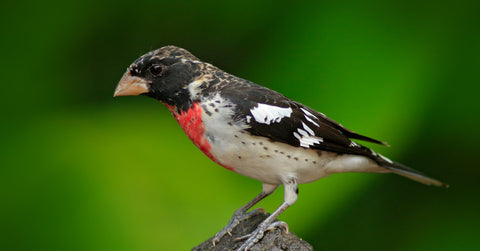
As spring quickly flies by, we can’t possibly let it pass without featuring one of the most beautiful songbirds in North America: the Rose-breasted Grosbeak. Part of the Cardinal family, the Pheucticus ludovicianus is a long-distance migratory bird commonly found all throughout the United States, Canada, and northern South America.
What Does the Rose-breasted Grosbeak Look Like?
Stocky and vibrant, the Rose-breasted Grosbeak’s appearance is true to its name. This mid-size bird is known for having a broad chest upon which a triangular-shaped red chevron is proudly displayed. Rose-breasted Grosbeaks are notoriously chunky, with short necks and medium-length, square tails.
Adult males are black and white with the characteristic red chevron that extends from their black throats down the middle of their breasts. They also flash pinkish-red underneath their wings. Adult females and younglings, however, look decidedly different; the females are brown and heavily streaked with a bold white stripe over an eye. They flash yellow under their wings. Both male and female Red-breasted Grosbeaks have white patches on their wings and tails.

Where to Find the Rose-breasted Grosbeak
Common among Eastern forests in the US, Canada, and Mexico, the Rose-breasted Grosbeak can be found in leafy woodlands, specifically in deciduous and coniferous trees. They tend to shift north for breeding season, which takes place from late spring into early summer. During non breeding seasons, the birds migrate all around the US, typically at night. These speedy fliers are known for making long trips fast. Sometimes they even fly across the entire Gulf of Mexico in just one night!

Breeding the Rose-breasted Grosbeak
Female Rose-breasted Grosbeaks typically lay between 3-5 bluish/greenish speckled eggs per brood; most families have 1-2 broods per year. Both female and male grosbeaks incubate the eggs for an average of 13-14 days and feed them for several days afterwards. This bird is known for building such loose nests that the colorful eggs are sometimes visible from the bottom.

How the Rose-breasted Grosbeak Behaves
These birds may have beauty, but they are equally brazen. Both male and female grosbeaks tend to be aggressive and territorial of their nests. Males sing in whistled phrases (akin to a better version of the American Robin’s song) to ward off intruders. As pretty as they may be, onlookers must beware: Rose-breasted Grosbeaks are known to attack people, animals, and fellow grosbeaks that come too close.

Male Red-breasted Grosbeak defending his territory
Feeding the Grosbeak
The Rose-breasted Grosbeak has a rather varied diet, rich in fruit, seeds, and insects. They love berries, black oil sunflower seeds, striped sunflower seeds, and safflower seeds. As for insects, they have an affinity for beetles, caterpillars, true bugs, spiders, and snails. If you have a seed cylinder, you’re in luck! These birds are known to eat out of them, as well as foraging in shrubs and trees.
Hear the Rose-Breasted Grosbeak Song!

Rose-breasted Grosbeak (male) perched on a branch
photo credit: Slow Turning via Flckr.com
The Impact of Climate Change on the Rose-breasted Grosbeak
Like all other migratory birds, climate change is messing with the schedule of Rose-breasted Grosbeaks’ migrations. Spring’s earlier arrival in the East and later arrival in the West is disrupting the songbird species’ ability to access their usual insect buffet, and is also having an impact on how the trees they depend on bear fruit. While these birds are not considered rare or endangered (yet), the 35% decline from 1966 to 2015 has caused some birders to start to worry.

Help keep the beautiful Rose-breasted Grosbeak coming to your neck of the woods when you feed the birds with these suggested Valley Farms® wild bird feed :





